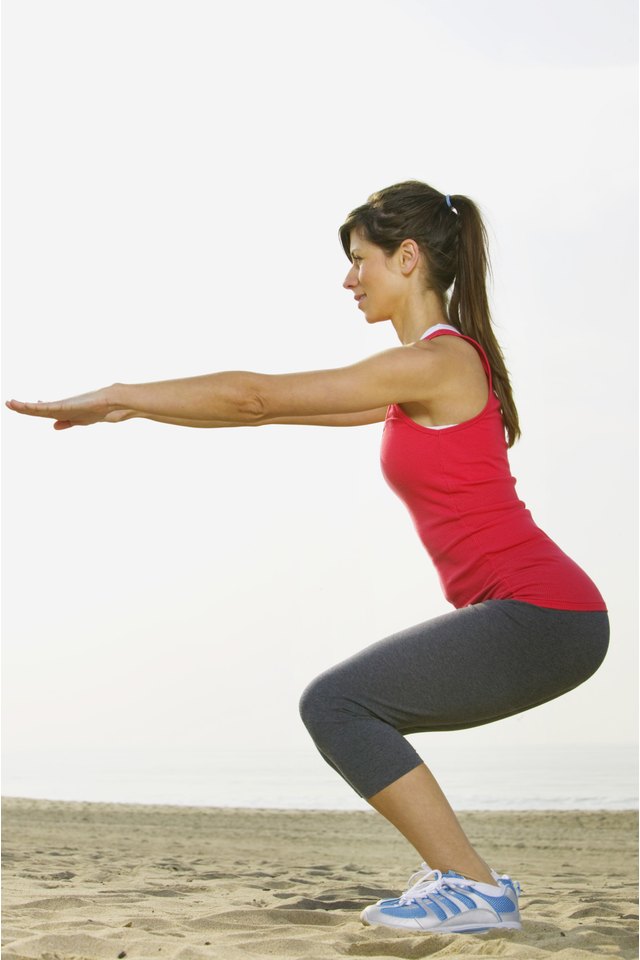Sore Muscles After Squats

Squats are performed by lowering the body to a near-seated position with the hips and knees while holding the arms extended and returning to a standing position. Because of the number of muscles involved in the exercise, squats assist with developing and strengthening much of the body. The amount of work that these muscles do during a workout can lead to muscle soreness for hours or days after the workout has ended.
Affected Muscles
The most common sites for muscle soreness after squats are the upper legs and the glutes due to the large amount of work they do during the exercise, but soreness can occur in other locations as well. Both the lower and upper back can become sore during squats, as can the shoulders and upper arms since the arms are extended during the exercise. Muscles used to stabilize the body such as the abdominals and obliques can become sore as well.
Delayed Onset Muscle Soreness
Sore muscles after squats often present as delayed onset muscle soreness, sometimes referred to in fitness circles as DOMS. This soreness typically appears within 24 hours of your exercise routine, though it can begin much earlier. Soreness from DOMS can be dull or intense and typically grows more intense as the affected muscles are flexed or otherwise used. DOMS-related soreness can last for several hours and may last for two or three days. Sudden sharp pains associated with exercise are not a symptom of DOMS and could indicate a more severe injury. Consult a doctor about this type of pain.
Using Proper Technique
One major cause of soreness after squats is improper exercise technique. Though muscle soreness can still occur due to the natural tears and damage that occur in the muscles during exercise, using improper form during squats increases the likelihood of muscle strain and injury. Performing squats correctly requires balance and the coordination of muscles in the legs, hips, back, shoulders and arms; leaning too far forward or back, placing the feet improperly or otherwise using improper form can throw off this balance and result in some muscles having to work harder than others to keep you from falling.
Treating Sore Muscles
You can treat sore muscles with rest, ice, heat, massage and over-the-counter medicines that feature anti-inflammatory components such as ibuprofen. Ice should be applied in short intervals for the first 24 to 36 hours to reduce swelling and ease the pain, after which heat can be applied to further soothe the muscles and promote healing. A study by researchers at Edith Cowan University, published in the Journal of Athletic Training in 2005, found that massage can reduce pain and swelling associated with DOMS by up to 30 percent. Massage does not help to restore flexibility and muscle function, however, so you should hold off on further exercise and continue treatment until your normal range of motion is restored. If the soreness continues for more than a few days, consult your doctor.
Preventing Muscle Soreness
Though muscle soreness often goes hand-in-hand with muscle development, there are ways to prevent at least some muscle soreness when performing squats. A snack or light meal that contains protein and carbohydrates an hour or more before exercising provides fuel for the body and protein that is necessary for muscle growth, and drinking cool water 20 minutes or more before you exercise encourages proper hydration. Eat another high-protein snack after you've completed your squats, and drink plenty of water to counteract fluid loss through sweat. Stretch and warm up before you begin your squats, and take the time to walk or perform other cool-down exercises afterward to encourage proper blood flow and relax the muscles. Stop performing squats if you experience sudden sharp pains as this may indicate a serious injury.
References
- American Council on Exercise: Bodyweight Squat
- American Council on Exercise: What Causes Muscle Soreness and How Is It Best Relieved?
- American Council on Exercise: If My Muscles Are Sore from Previous Workouts, Is It Safe to Exercise Them?
- MayoClinic.com: Muscle Pain: When to See a Doctor
- Edith Cowan University: Effects of Massage on Delayed-Onset Muscle Soreness, Swelling, and Recovery of Muscle Function
Writer Bio
Born in West Virginia, Jack Gerard now lives in Kentucky. A writer and editor with more than 10 years of experience, he has written both articles and poetry for publication in magazines and online. A former nationally ranked sport fencer, Gerard also spent several years as a fencing coach and trainer.
